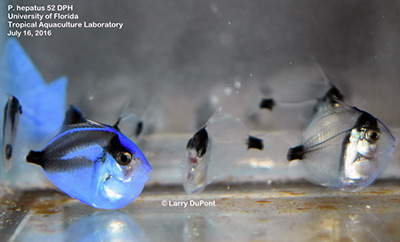Yep, you read that right…and, no, I am not talking about “tank-raised,” a term sometimes mistaken for “tank-bred.” “Tank-raised” (taking young post-planktonic-stage fish and raising them to sellable size) Pacific blue tangs have been available for quite some time (at least since 2011), but breeding and raising Paracanthurus hepatus has eluded aquarists since captive breeding became mainstream in the past decade.
Rising Tide Conservation’s efforts at the Oceanic Institute of Hawaii had the first breakthrough earlier this year with a relative, the yellow tang, Zebrasoma flavescens. From there, a model of success was derived. For the past four and a half years, Kevin Barden with SeaWorld has worked on breeding P. hepatus and has finally cracked the code on these difficult baby fish.

What makes them difficult, you may ask? P. hepatus fry are extremely tiny and fragile. They take about three weeks to “settle” from their pelagic larval stage into their post-larval stage. Several bottlenecks were found when these larvae began developing. As it turns out, it seems feeding a food with the right nutrients to the broodstock (the adult breeding P. hepatus) ended up likely being the key to larvae survival!
About a year ago, Rising Tide Conservation and SeaWorld partnered with Larry’s Reef Services and began feeding the broodstock LRS Fertility Frenzy™ exclusively. Why all the hype? It is possible that Fertility Frenzy™ played a huge part in giving the young larvae the boost they needed to get through the first stage of life. It may be that improving the body condition of the parents resulted in the larvae having more yolk to feed from. Parent fish with more energy to put into their progeny tend to have stronger, faster-developing progeny!

The question now becomes, in what other breeding projects could a better broodstock diet help improve the survival of larvae and young fish? It could be a key ingredient in breeding other species of fish that have difficult larval stages!



